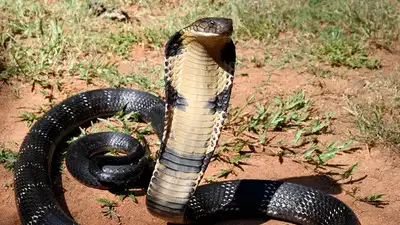10 king cobras found near Mount Everest in Kathmandu; experts say this is a warning sign | - Times of India

In the span of one month, ten most venomous snakes including nine king cobras and one monocled cobra have been found in and around Kathmandu. These normally tropical and humid dwellers such as paddy fields, swamps, and mangrove forests were found startlingly near the Himalayan region, mere 160 kilometers away from Mount Everest.
In the shocking and horrifying turn of events the presence of king cobras around Mount Everest is not a one-off incident, it is a warning signal of the wide-ranging effects of global warming as per experts.From environmental disruptions to community safety concerns, the fact that these venomous snakes have shown up in colder climates is all the more reason to take immediate action to curb climate change and appreciate biodiversity changes.
Here are what experts have to say on this horrifying find of one of the most venomous snakes.
The longest venomous snake in the world, the King Cobra reaches up to 18 feet in length. As highly toxic neurotoxic venom producers, they typically live in dense highland forests, particularly in India, Southeast Asia, and the Philippines. It is extremely rare for them to be seen in the cool high-altitude areas of Nepal.
This species, distinguished by the round "monocle" spot on the rear of its hood, is found in South and Southeast Asia.
It tends to live in lowlands, marshes, and paddy fields, not in mountains.
The snakes were found in residential areas like Bhanjyang, Gupaleshwar, Sokhol, and Phoolchowk, as per reports in The Kathmandu Post. Rescue operations picked up the snakes from courtyards and houses and released them into forests safely. Rysterious finds like snake nests and eggs deep in the forest indicate that the reptiles could be settling and breeding in the region, indicating a wider ecological shift.
Scientists are of the opinion that the uncharacteristic movement of such snakes into colder areas are not just coincidental migration. It is increasingly being believed that climate change is forcing these reptiles to move out from their natural habitats. The rising temperature in Nepal's mountainous regions is a major contributing factor.Research indicates that hill and mountain temperatures in Nepal are increasing at a rate of 0.05°C per year, more quickly than in the Terai lowlands.
Consequently, warmer microclimates are allowing historically tropical species to survive and even flourish at high altitudes.
Although climate change is a prevalent theory, rescue instructor Subodh Acharya offers a second possible cause. He predicts that the snakes might have been inadvertently carried along with wood or haystacks on trucks moving from low-lying Terai to upper regions. Inadvertent transportation may have aided in opening up the species to new areas. Although most attention has recently been given to high-altitude observations, the Terai continues to experience a serious snakebite epidemic. A total of 2,700 people are killed each year in southern Nepal by venomous snakebites, women and children accounting for the majority of them. This highlights the persistent threat snakes pose to human communities, independent of habitat changes.Also Read | Four new snake species discovered in Papua New Guinea’s wild islands










